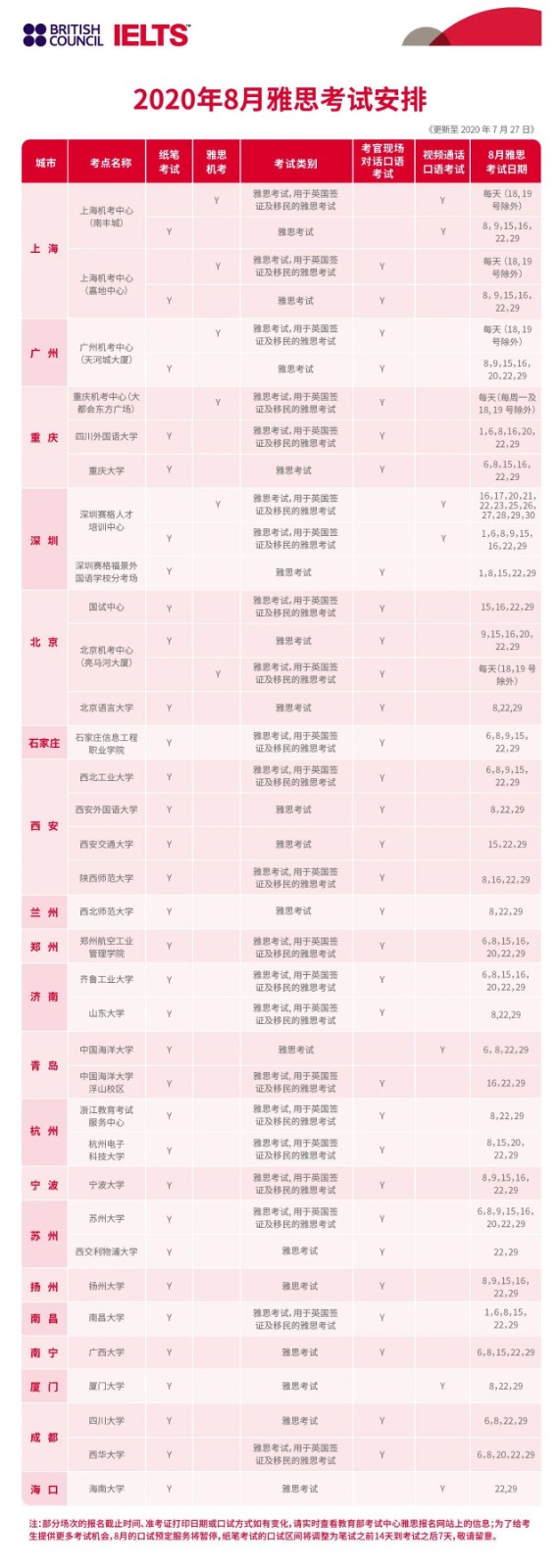托福听力有些词组听着耳熟却不懂意思?20个常用高频词组一览。今天小编给大家带来托福听力有些词组听着耳熟却不懂意思,希望能够帮助到大家,下面小编就和大家分享,来欣赏一下吧。
托福听力有些词组听着耳熟却不懂意思?20个常用高频词组一览
1.anything but
听力原句:
Librarian:Oh, well I guess you might think that. But when I saw it back then it was anything but boring.
语境释义:并不;一点也不
注:近似词组nothing but意为“只不过是”,例如:It's nothing but a joke.
2.in such short notice
听力原句:
Student:Hi, thanks for seeing me in such short notice.
语境释义:如此仓促
3.in person
听力原句:
Manager: Right, the choir. It’s nice to finally meet you in person. So, you are having problems with...
语境释义:亲自,当面
4.high-end
听力原句:
Pro: Ok, basically they have to offer things that most people can find anywhere else, you know quality, that means better exercise equipment,high-end stuff, and classes-exercise classes may be aerobics.
语境释义:高端的
5.drive…home
听力原句:
Therefore, it’s best to be a non-conformist – to do your own thing, not worrying about what other people think. That’s an important point. He really drives this argument home throughout the essay.
语境释义:把(论点、问题等)讲得透彻、明白
6.goof off
听力原句:
Student: I went off to the stack and found some really good material for my part, but when I got back to our table, they were just goofing off and talking. So I went and got materials for their sections as well.
语境释义:游手好闲,混日子
7.go down the drain
听力原句:
Student: I know, but I didn’t want to risk the project going down the drain.
语境释义:前功尽弃,付诸东流
8.start from scratch
听力原句:
Student: But we’ve got all the sources and it’s due next week. We don’t have time to start from scratch.
语境释义:从头开始
9.come down to
听力原句:
It’s been shaped by constraints over vast stretches of time, all of which comes down to the fact that the best foraging strategy for beavers isn’t the one that yields the most food or wood.
语境释义:归结为
10.open spot
听力原句:
I am afraid we don’t have any openings at lunch time. A lot of students want to work then, so it is really rare for us to have an open spot at that time of day.
语境释义:职位空缺
11.not necessarily
听力原句1:
Well, design doesn't necessarily include things like sculptures or decorative walkways or… or even eye catching window displays, you know art.
听力原句2:
Professor:That’s another possible reason although it doesn’t necessarily explain other behaviors such as eating, drinking or sleeping.”
语境释义:不一定,未必(不是“不需要”或者“不必要”的意思!)
12.be at odds with
听力原句:
They try to fit in with the rest of the world even though it’s at odds with their beliefs and their identities.
语境释义:与…相违背、相冲突
注:在听力中该短语会有连读,要多听。
13.lesser-known
听力原句:
Employee:You are lucky to have professor who includes the lesser-known writer like her on the syllabus, you know, not the usual authors we’ve all read.
语境释义:不知名的
14.pros and cons
听力原句:
I mean no one really thinks that, say a bee goes through weighing the pros and cons of pollinating this flower or that flower.
语境释义:权衡利弊,仔细斟酌
15.in a different light
听力原句:
Student: I mean... Being a waiter, I get to see a lot of the professors, like in a different light, we joke around a little you know. In the classroom, they always have to be pretty formal, but …
语境释义:从不同的角度,从另外一面
16.low key
听力原句:
Pro: Oh, that's very thoughtful of you, Eric, but it will be low key, nothing flashy. That's not her style.
语境释义:低调的,不张扬的
17.common denominator
听力原句:
There are variations on this model of course, but the common denominators are always an idea of creating a shopping space that will get people to shop in the city without needing their cars.
语境释义:共同点,共性
注意:denominator本意为“分母”
18.tongue in cheek
听力原句:
But if you took away all the DNA that codes for genes, you still have maybe 70% of the DNA left over. That’s the so-called JUNK DNA. Though the word junk is used sort of tongue in cheek.
语境释义:半开玩笑地
19.pull them from thin air
听力原句:
To begin, how do we create fictional characters? We don’t just pull them from thin air, do we? I mean we don’t create them out of nothing.
语境释义:凭空捏造
20.touch base
听力原句:
Advisor: Hi, Steven I schedule this appointment, cause it has been a while since we touched base.
语境释义:联系,进行接触
2020托福听力练习:木星大红斑释放神秘能量
For most people, Jupiter's most recognizable—and mysterious—feature is the Great Red Spot. For centuries, astronomers have watched the storm spin across the giant world's face.
But for planetary scientists, Jupiter's most distinctive mystery may be what's called the "energy crisis" of its upper atmosphere: how do temperatures average about as warm as Earth's even though the enormous planet is more than fives times further away from the sun?
All the sun's giant planets display this energy crisis, and those in chilly orbits around other stars probably have it, too. So where does the energy to heat their upper atmospheres come from?
According to a new study, the energy must originate within the giants, get transported upward and become amplified by turbulent storms. The finding appears in the journal Nature.
This offers a new window into Jupiter's depths, and should allow researchers to better understand gas-giant atmospheres throughout the universe. And it's all connected to the Great Red Spot.
Astronomers have long known that auroral displays can heat Jupiter's poles, where charged particles trapped in the planet's intense magnetic field slam into its upper atmosphere. Some theorists thought this auroral heating could flow toward the equator to warm the planet's mid-latitudes. So, using NASA's Infrared Telescope Facility, astronomers observed Jupiter for nine hours, looking for these flows as thermal fluctuations in the planet's upper atmosphere.
But they saw none.
Instead, in Jupiter's mid-latitudes they spied a thermal spike 800 kilometers above the Great Red Spot, where temperatures soared hundreds of degrees higher than the surroundings. The best way to explain this spike is from the swirling maelstrom below, where turbulent atmospheric waves must generate heat by crashing together like breakers on a windy beach shore. Though this must be a planet-wide phenomenon, it is most obvious directly over Jupiter's largest, most powerful storm.
As alien as it seems, scientists have seen the same behavior on much smaller, gentler scales here on Earth, when thunderheads rising over mountain ranges create rippling waves that heat the air above.
对大多数人来说,木星最容易辨认、最神秘的特征在于:大红斑。数个世纪以来,天文学家已经观察到了木星表面这一风暴气旋。
但是对行星科学家来说,木星最最独特的神秘之处在于所谓的上层大气中的“能源危机”:木星这颗巨大行星到太阳的距离比地球到太阳的距离远五倍以上,可是为什么其平均温度却和地球一样温暖?
所有太阳系中的巨行星都呈现出这种能源危机,而那些在寒冷轨道围绕其他恒星运转的行星可能也会出现这种能源危机。那么,使上层大气升温的能源从何而来?
一项新研究表明,这一能源肯定源自巨行星,然后向上输送,并通过猛烈的风暴扩大。该项研究结果发表在《自然》杂志上。
这为探索木星深处提供了一个新视角,并且这一发现使研究人员可以更好地了解整个宇宙中巨型大气层的奥秘。而这一切都与大红斑有关。
天文学家很早以前就知道极光可以使木星的两极升温,这是因为被困在木星强磁场中的带电粒子和其上层大气发生了猛烈撞击。一些理论家认为,这种极光加热可以向赤道流动,从而使木星中纬度地区变暖。所以,天文学家利用美国航空航天局的红外望远镜设备观测了木星9个小时,试图在木星上层大气发生热涨落时寻找这一热流。
但是他们什么都没看到。
相反,在木星的中纬度地区,他们在大红斑上方800公里处发现了温度峰值,相比于周围的温度,这个地方的温度飙升了几百度。对此最好的解释是这种温度飙升来自下方的漩涡,那里的大气湍流通过互相碰撞产生热量,就像在起风的沙滩上拍打海岸的白浪一样。虽然这是一种宇宙现象,但木星最强大的风暴使其尤为显著。
虽然看起来很奇怪,不过科学家已经在地球上发现了规模较小、较温和的相同现象,当雷雨云砧上升越过山脉,就会产生加热上方空气的微波。
1. even though 即使;尽管;纵然;
例句:The book is a mirror of his life even though it is not a biography.
这本书虽然不是传记,但仍旧是他生活的写照。
2. come from 来自;始于;
例句:Correct ideas come from social practice.
正确的思想来自社会实践。
3. according to 依据,根据,依照;
例句:You've been in prison six times according to our records.
根据我们的记录,你曾入狱六次。
4. slam into 猛烈撞击;
例句:The plane slammed into the building after losing an engine shortly after take-off.
飞机起飞之后不久,就有一个引擎出现故障,随即便一头撞上了大楼。
2020托福听力练习:聪明的蚂蚁备份导航系统
Make a left at the big oak tree about a mile down the road. That kind of direction is common in landscapes filled with visual cues. But the Sahara desert is a much tougher place to navigate. Even any footprints you leave get erased as winds massage the sand. Nevertheless, ants in the desert go on searches for food—and once they find it they carry their prize directly back to the nest.
In the late 1980's, researchers discovered that the ants can achieve this impressive feat using a process called path integration. To gauge the direction home, they keep track of the sun's motion across the sky—just like sailors used to do. To calculate the distance, they count their steps.
"It's a very hostile environment. They're foraging at the hottest times of the day and it's a desert, so surface temperatures reach 60 to 70 degrees Celsius."
Neurobiologist Matthias Wittlinger from Germany's Ulm University, on the podcast of the journal Science, which published this work.
"And they need to be really quick in finding food, and they really need to be very quick in getting the food back to the nest...they need to be really fast, and they're travelling at speeds of 100 body lengths per second."
Wittlinger noticed that sometimes desert ants carry each other.
"And here we had this unique opportunity to test traveling ants that are not walking."
If they're not walking, then they can't count their steps. So would these ants be able to find their way home?、
Bees and wasps can't count their steps, because they fly. Instead, to estimate distance they rely on what's called optic flow, which tracks how much visual information flows past them while they travel. So, do carried ants also use optic flow?
To find out, the researchers waited for an ant to emerge from its nest carrying another. After the pair walked for ten meters, the researchers separated them. And impressively, the carried ant marched straight on back to the nest—but not if their vision was blocked.
"So if they were blindfolded while being carried, they have no chance of gaining any distance information."
Which proves that they need eyesight—and therefore optic flow—to do it.
These critters live in one of the harshest environments on the planet, so it makes sense that evolution endowed them with the tools for path integration and optic flow.
"In the case of the desert ant, it's really important that they're getting navigation right...if one system fails, you still have a backup system."
Because if you're going to live in the desert you have to be very clever in finding ways to not die in the desert.
沿着这条路走,在大约一英里处的大橡树那里左拐。这种导航方向在有视觉线索的地形非常常见。但是撒哈拉沙漠是一个很难导航的地方。即使你留下脚印也会被风沙覆盖。然而,在沙漠中的蚂蚁却能够继续寻找食物,一旦它们发现食物,它们可以直接把食物搬回巢穴中。
上世纪80年代后期,研究人员发现蚂蚁可以实现这一了不起的壮举,这被称为路径整合。蚂蚁跟踪太阳在天空中的运动情况来判断回家的方向,就像过去水手们做的一样。它们通过计算步数来计算距离。
“这是一个非常恶劣的环境。它们在一天最热的时间觅食,沙漠的表面温度高达60到70摄氏度。”
德国乌尔姆大学的神经生物学家马蒂亚斯·威特林格在本周《科学》期刊的播客上发表了这项研究成果。
“它们要快速找到食物,还要快速把食物带回巢穴……它们的动作要非常快,基本上它们每秒的速度要达到身长的100倍。”
威特林格指出,有时沙漠蚂蚁会互相背着前进。
“我们有这个独特的机会来测试那些没有走路的觅食蚂蚁。”
如果它们不走路,那它们就不能计算步数。那这些蚂蚁能找到回家的路吗?
蜜蜂和黄蜂不能数步数,因为它们靠飞行移动。所以,它们依靠光流来计算距离,它们会根据飞行过程中的视觉信息流来估算距离。那被抬着的蚂蚁也用光流来计算距离吗?
为了弄清楚这点,研究人员等待一只蚂蚁背着另一只蚂蚁从它的巢里出现。在它们走了十米以后,研究人员把它们分开了。令人印象深刻地是,如果视野受阻,那被背着的蚂蚁会径直返回巢穴中。
“如果它们在被背着时眼睛被蒙住,那它们就没有机会获得任何有关距离的信息。”
这证明它们需要视力,也就是要它们需要光流。
这些生物生活在地球最恶劣的环境中,所以进化赋予它们路径整合和光流的能力是有道理的。
“在沙漠蚂蚁的例子中,获得导航能力是非常重要的……如果一个系统失败,它们还有一个备份系统。”
因为如果要在沙漠中生活,你必须要非常聪明,这样才能找到路而避免死在沙漠中。
重点讲解:
1. keep track of 跟上…的进展;掌握…的最新消息;
例句:I keep track of my expenses in a notebook.
我把我的支出记在一个笔记本上。
2. rely on 依赖;依靠;
例句:In default of expert's help, you'll have to rely on yourselves.
没有专家的帮助,你们只好依靠自己了。
3. find out (尤指特意通过努力)发现,找出,查明;
例句:He was asked to find out how the land lies.
有人要他探知事情的真相。
4. make sense 可以理解;讲得通;
例句:Delaying their retirement by raising the pensionable age might make sense.
通过推迟拿养老金的年龄而让他们迟点退休,可能还有道理。
5. endow with 赋予;使天生拥有;
例句:You are endowed with wealth, good health and a lively intellect.
你生来就拥有财富、健康和活跃的思维。








 扫一扫支付
扫一扫支付


